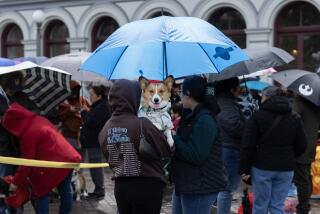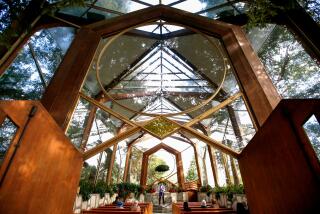Plans for pet repository in San Francisco spur theological flap
SAN FRANCISCO — This is, after all, the City of St. Francis. So when a shrine named in his honor announced plans to build a repository for pet ashes in a catacomb-like hollow under the stairs of its 19th-century church, many animal lovers were elated.
Little did they know the plan would stir old-fashioned church politics and deep theological questions. (Is the stair nook a sacred space? Does placement of cinerary urns equate to pet burial? Did St. Francis only care about living creatures?)
Now, as plans for the pet columbarium move forward, critics are taking their concerns well up the church hierarchy.
Tucked between North Beach tourist cafes, the sanctuary hosts a popular blessing of the animals that draws hundreds of people twice yearly — along with their cats, dogs, gerbils, chickens and more.
A resting place for pet cremains seemed more than fitting to Bill McLaughlin, pet advocate and chairman of the National Shrine of Saint Francis of Assisi. The Marin County developer was overseeing church renovations as a volunteer when he happened upon the previously undiscovered alcove under the shrine’s front steps.
He proposed the idea to the shrine’s Franciscan Capuchin friars, who ran it by San Francisco Roman Catholic Archbishop Salvatore Joseph Cordileone, and with little discussion the project now known as St. Francis Rest was set in motion.
Interest in the glass-fronted niches for urns and memorabilia has been strong — from pet lovers and even from San Francisco police officials who hope to place remains of working horses and dogs in an “honor hall” designated for service animals.
The shrine’s rector, Father Harold Snider, said the project will provide solace to the grieving while placing the little known national treasure on the map, amplifying the power of its core mission “to proclaim Jesus Christ.”
“There’s a clientele who really do want to participate,” said Snider, who discovered St. Francis as a 6-year-old and entered the seminary two decades later. (His childhood pets included three dogs, three cats, a rabbit, a rooster, a duck and “assorted fish and turtles.”)
Still, the endeavor has met some fierce pushback.
A spokesman for the International Association of Pet Cemeteries and Crematories said the project appears to be the first in North America to site a pet columbarium on church grounds.
The Knights of St. Francis here have taken exception — noting that Pope Francis himself has disdained excessive wealth spent on pets as bordering on idolatry. (The new pope is the namesake of the patron saint of animals. But critics note the saint has never been associated with dead animals.)
The knights, who volunteer to guard the shrine’s scaled replica of the chapel restored by St. Francis, note that pet funerals are against church teaching. Animals are not capable of sin, do not go to heaven or hell and thus cannot be saved, the reasoning goes.
Besides, said Tory Hartmann, a knight on that organization’s board, couldn’t the energy be better spent?
“I just love our little pets but this makes me uncomfortable,” said Hartmann. “The issue to me is should we be spending our time and money on this when you almost have to walk over homeless people to go in there ... Is this what we want to be known for?”
The church was founded in 1849 in a “shack” in San Francisco’s Presidio. The current structure dates to 1860. While much of its interior was destroyed in the 1906 earthquake, its supports remained intact and a new church rose from the original walls.
The church was shuttered for four years before reopening in 1998 — with the help of then-Archbishop William Levada, who was later a top Vatican official, and Angela Alioto, a former San Francisco supervisor and devout Franciscan from a storied political family. Status as a national shrine followed a year later.
Alioto said she and Levada in 2005 crafted a revitalization plan that included the shrine renovations and construction of the replica chapel known as La Porziuncola Nuova. She formed the Knights of St. Francis here to safeguard it. Plans for a new piazza and interior renovations are pending.
Levada moved on, and McLaughlin, who chartered 737s to rescue dogs after Hurricane Katrina and keeps the remains of a beloved Labrador in a cedar box in his closet, is close to the church’s new leadership. The mid-June blessing of the animals was upcoming when he stumbled on the opening under the stairs. His idea for the pet columbarium fell on receptive ears.
Alioto said she and many other Franciscans find the concept disrespectful and “simply not appropriate at the National Shrine of Saint Francis.” She has written to Levada in protest and broached the topic in a meeting with international leadership of the Capuchin friars.
“No scholar I know, nor myself, a street scholar on Saint Francis, see any causal connection between Saint Francis and dead animals,” she wrote in an email from Italy, where she spends summers and, on Friday, attended St. Francis’ Day of Pardon at the original Porziuncola in Assisi for the 41st time.
McLaughlin said he “did anticipate the theological discussion, but we never looked at it as a theological exercise. … We always looked at it as a way to minister to the families.”
St. Francis, the thirteenth century founder of religious orders dedicated to the service of the poor, believed all creation mirrored the love and beauty of God. Murals inside the national shrine’s main church depict him blessing the birds and taming the once-fierce wolf known as Gubbio.
While some try to narrowly interpret the saint, McLaughlin said, he is “many things to many people. Some people identified through poverty, some identified through animals.”
Snider, who inherited the project this month from the former rector, said he gained “a lot of confidence” after receiving his first query, from a dog breeder concerned about the fate of her cremated pet remains.
Joan Jensen, who breeds and shows Pembroke Welsh corgis, said a friend picked up a pamphlet about the project and passed it on. An inactive Catholic, Jensen hopes to participate — the pet columbarium will be open to people of all faiths or no faith.
So far, she has the cremains of 11 dogs in boxes in her San Francisco home (there is no yard in which to bury them) and three living dogs who will likely meet the same fate.
“I hope this materializes,” she said. “I hate to think of my pets’ ashes in the garbage.”
Snider takes the criticism in stride, stressing with a smile that there will be no burials or funerals for pets — only prayers for the living if they seek them. St. Francis Rest is located under the stairs protruding from the church, not in or under the church, he has noted, so doesn’t violate canon law.
“Everything we are doing and will do is presented to the archbishop,” he said. “You could hand gold bars out in the middle of the street and someone would complain that you were blocking traffic. You’ve just got to roll with it.”
More to Read
Start your day right
Sign up for Essential California for news, features and recommendations from the L.A. Times and beyond in your inbox six days a week.
You may occasionally receive promotional content from the Los Angeles Times.







